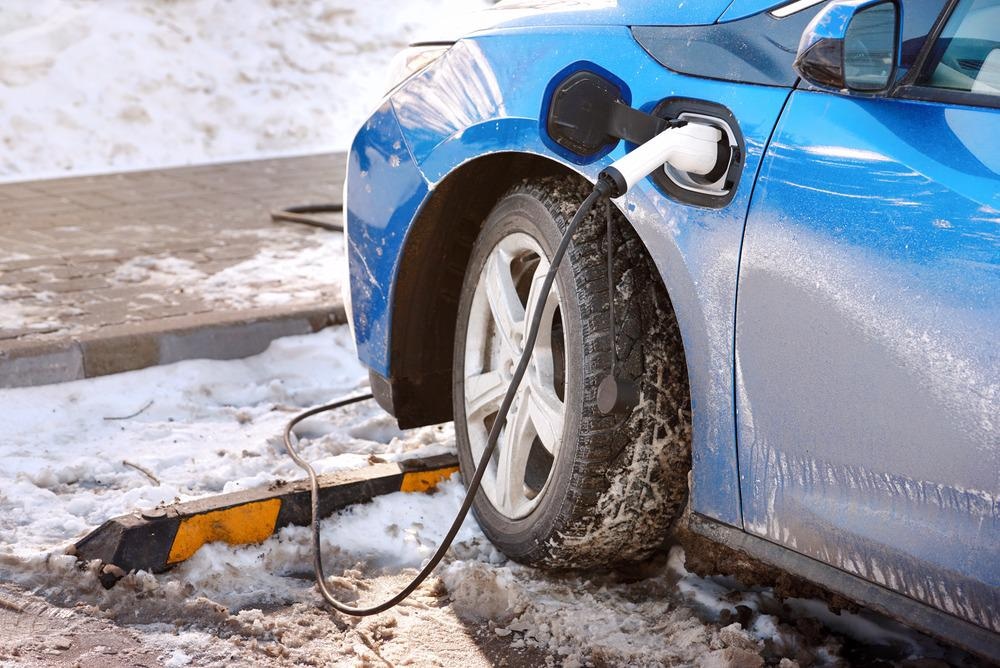Lower temperatures tend to reduce battery capacity, which means that the possible range and performance for electric vehicles are worse in colder climates. Responding to this challenge – and the pressing need to move away from fossil fuel-based transportation as soon as possible – a research team in Sweden recently demonstrated how batteries for electric vehicles can work in cold climates with an innovative thermal encapsulation platform.

Image Credit: Tricky_Shark/Shutterstock.com
Thermal Encapsulation Can Increase Range in Electric Vehicles
Fossil fuel-powered transportation is being gradually phased out, with battery electric vehicles taking a bigger share of the new vehicle market each year. The freight market for electric vehicles is growing fastest, with significant benefits available to the logistics industry for switching to electric.
Freight companies need vehicles that perform reliably over time, potentially taking regular routes that traverse entire continents. Electric vehicles for these companies need to be able to work in extreme conditions.
The lithium-ion batteries used in most battery electric vehicles suffer reduced charging efficiency, significant capacity loss, and accelerated aging in low temperatures. This has a negative effect on electric vehicles’ driving range – how far they can travel between charges.
In order to continue growing the electric vehicle market, manufacturers and researchers are focused on developing low-temperature battery solutions to maintain acceptable levels of range in cold climates.
Research has already been done to demonstrate that insulating lithium-ion battery packs can help them perform better under low external temperatures. However, this technique had previously not been studied in an electric vehicle context, taking drive and charge cycles into account.
A new study from vehicle engineering and autonomous systems researchers in Sweden’s Chalmers University of Technology investigated the effect of thermal encapsulation on large lithium-ion battery packs for electric truck applications.
The researchers said that battery climatization to optimal operating temperatures is essential for battery performance and longevity. Most electric vehicles today use a heating system to bring the battery up to optimal working temperatures when it is operated in a cold climate. As well as exposing the battery to cold temperatures (reducing its capacity), this also drains electric vehicles’ power supply and reduces range.
The paper, published in the journal Applied Thermal Engineering in 2022, demonstrated that encapsulating electric truck batteries with commercially available thermally resistant materials led to significantly reduced heat loss and helped the battery maintain optimal operating temperatures.
Testing and analysis revealed that the thermal encapsulation platform could provide energy savings of approximately 15% when the truck is parked in overnight conditions – for 12 hours at ambient temperatures as low as −25 °C (−13 °F).
The Swedish automobile manufacturer, Volvo, was also involved in the study. Their division, Volvo Group Truck Technology, is pioneering development in electric vehicles for freight and logistics and can be expected to implement the battery encapsulation technique as soon as it becomes viable.
Can You Use Electric Vehicles in Cold Climates?
Lithium-ion batteries are rechargeable, lightweight, and capable of higher energy density than most other available battery types. They are smaller than the batteries used to start gas-powered vehicles’ internal combustion engines.
Of course, as well as starting the car, batteries in electric vehicles keep it moving, often through different modes or power outputs, and they run the vehicle peripherals like air conditioning, entertainment, and driver assistance systems.
When lithium-ion batteries are exposed to cold temperatures, their storage capacity – the measure of how much energy they can store between charges – drops to approximately 77% at around −15 °C (5 °F).
Discharge capacity is the measure of how quickly a battery can discharge its energy – in other words, how much of its stored power it can transfer to the machine that is drawing from it. At the same experimental temperatures as above, lithium-ion batteries were found to discharge at about 82% capacity.

Image Credit: Mulevich/Shutterstock.com
Electric vehicle range is limited in cold climates in part by these direct effects of low temperatures on lithium-ion battery capacity and performance, but also by comfort factors inside the vehicle.
Heating the cabin area of the vehicle requires significant amounts of power in cold climates (as does cooling the cabin in hot climates). Testing has shown that, because of this, electric vehicles’ range is reduced to approximately 45% when the external temperature is −15 °C (5 °F) or lower.
This significant power drain is perhaps surprising: gasoline-powered vehicles do not have excessive heating requirements. This is actually due to unavoidable inefficiencies in internal combustion engines which emit significant amounts of heat – energy that is not used on propulsion and is usually wasted.
Electric vehicles, on the other hand, use a much more efficient, electrified drive shaft. This creates minimal excess heat, and therefore leaves a greater heating requirement for comfort in cold temperatures.
Currently, most electric vehicles still perform adequately in all but the most extreme conditions. As research and development in this sector continue to progress at a rapid pace, electric vehicles will (and in many cases already do) present a viable, greener solution to transportation requirements in every corner of the planet.
More from AZoM: What Do We Know About Thin Film Solar Cells?
References and Further Reading
Aris, A.M., and B. Shabani (2017). An Experimental Study of a Lithium Ion Cell Operation at Low Temperature Conditions. Energy Procedia. doi.org/10.1016/j.egypro.2017.03.117.
Babu, A.R., B. Minovski, and S. Sebben. (2022). Thermal encapsulation of large battery packs for electric vehicles operating in cold climate. Applied Thermal Engineering. doi.org/10.1016/j.applthermaleng.2022.118548.
Fuel Economy in Cold Weather. [Online] Department of Energy. Available at: https://www.fueleconomy.gov/feg/coldweather.shtml
Laukkonen, J. (2021). How Well Do EVs Work in Extreme Cold or Heat? [Online] Lifewire. Available at: https://www.lifewire.com/how-well-do-evs-work-in-extreme-cold-or-heat-5202163
Disclaimer: The views expressed here are those of the author expressed in their private capacity and do not necessarily represent the views of AZoM.com Limited T/A AZoNetwork the owner and operator of this website. This disclaimer forms part of the Terms and conditions of use of this website.